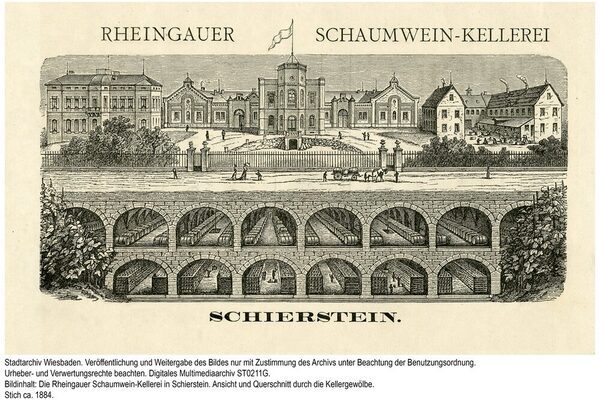Söhnlein, sparkling wine cellar
Johann Jacob Söhnlein, born in 1827, settled in Schierstein at a young age and bought a manor house with a farmstead and some land. In 1855, he founded the Nassauische Gesellschaft für Tabakbau und Cigarrenfabrikation with various partners (Dennemann, Rothe, Poths), which he maintained until 1886. This was followed in 1864 by the founding of the Rheingau sparkling wine factory, which later became Söhnlein Rheingold Sektkellerei KG.
In competition with French champagne, the sparkling drinks from the House of Söhnlein were soon able to assert themselves worldwide: in 1876, the "Rheingold" brand was registered as the first German sparkling wine brand in the trademark register, followed by other brands such as "Kaiser-Monopol" and "Silbermarke". They were shipped to the branches in London and New York as well as 65 of the company's own domestic and foreign warehouses. Söhnlein had wrested the name "Rheingold" from Richard Wagner, who was staying in Biebrich in 1862. According to an imperial decree, only "Rheingold" could be used when launching German warships and merchant ships.
Söhnlein gradually expanded his winery. In 1895, he had the architect Alfred Schellenberg build a new winery building near the Schierstein harbor with a rail connection, the Rheingau-Palais. This period also saw the transformation of the public limited company into the family business S. & Co. Rheingauer Schaumweinkellerei.
After the death of the company founder in 1912, his son, Friedrich Wilhelm Söhnlein, took over the management of the company. In 1958, the founder's grandsons sold the company to the Oetker family. In 1986/87, the shareholders of Söhnlein Rheingold KG - the children of Rudolf August Oetker - also took over Sektkellerei Henkell & Co. Both companies were combined to form Henkell und Söhnlein Sektkellereien KG (until 2009), based in Biebrich. The Schierstein "Villa", the "Söhnlein Palais" on Kettenbornstraße, which was destroyed in a bombing raid in 1942, was restored to its original form in 1980. Today it houses the offices of various companies.
Literature
The legacy of the Mattiaca. Personalities of the city history of Wiesbaden. Ed.: Gesellschaft zur Pflege von Dialekt und Stadtgeschichte Wiesbadens Mattiaca, Wiesbaden 1992 [p. 221 f.].
